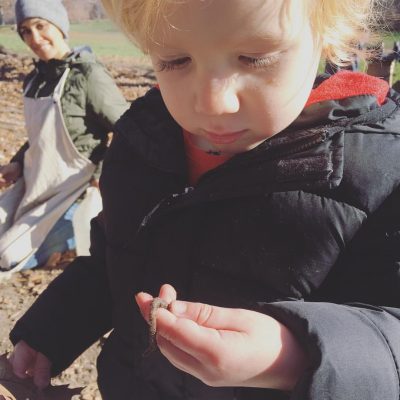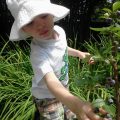
Written by Suzanne, Chief Health Officer and Resident Grandmother
You know that I’m all about nature, especially when it comes to kids. The outdoors offers both a stimulating environment that kids love and it never squashes their imagination. This is a magical combination, and one that is increasingly under-utilized.
Spring is the perfect time to get back in the habit of outdoor play. With spring come the many sights, smells, and sounds of nature. Plus, warmer weather means it’s easier and more pleasant to be outside. And the rain? Unless thunderstorms or flooding are in the forecast, don’t let wet conditions keep you indoors. Most kids love the rain and puddles and mud. There are few puddle-jumping messes that a bath and washing machine won’t take care of!
Non-toxic Rain Gear
Be sure to choose only the Good Stuff when it comes to rain boots and jackets (which basically means avoiding PVC). We like PuddleGear, Hatley, Hunter, and Tretorn.
Having four young grandsons means I get to observe and experiment with a lot of outdoor play. Below are some of my favorite outdoor activities for toddlers and older kids.

Outdoor Play for Toddlers
For younger children, simply spending time outside and allowing them to explore is best. If you live in a city, find a park with some wild places. If you can, get in deep enough to avoid some of the transportation noise.
My two-year-old grandson goes to a “Forest School” in his local park. The children have sticks and rocks and play in the dirt under the trees. It’s so simple, and they love it!
This goes without saying, but you do have to supervise toddlers so that no one gets hurt or wanders off. Also, think of playing in nature as a good opportunity to teach kids to be gentle with trees, plants, and small creatures. Toddlers are naturally curious and can sometimes be a little destructive, but you can model gentle play. Teach kids to follow their curiosity without leaving a path of torn plants and squashed beetles in their wake.
Outdoor Play for School-Aged Kids
Joseph Cornell’s Sharing Nature with Children is a classic book that I used when my children were young. These days, it continues to inspire me as a grandmother. It’s full of activities to increase children’s awareness of nature and develop their minds and senses.
Just exploring outside can be enough, but for school-age children, Cornell’s Blind Walk is a great activity. It is best for children who are seven years old or older. According to Cornell,
Blindfolded activities dislodge our thoughts from self-preoccupation, and free our awareness to embrace more of the world around us. Vision is the sense we depend on the most. Deprived of it, we must fall back on our less-used senses of hearing, touch and smell. Our attention is powerfully focused on these senses, and our perceptions through them are intensified. The babbling of our mind slows down, overwhelmed by the information that our fully awake senses are giving us.
A Blind Walk is simple to organize and lead. For supplies, all you need is one blindfold per pair of people. Here’s how to do a Blind Walk:
- Form pairs, with mixed adults and children, or children together if they’re mature enough.
- Each pair decides who will be the leader first and who will be blindfolded. The leader guides his partner along any route that looks interesting. Be very careful to watch for logs, low branches, and so on.
- The leader also guides his blind partner’s hands to interesting objects and brings him within range of interesting sounds and smells.
- Remember to demonstrate how to guide a partner safely. Remind the leaders that they are the eyes of their blindfolded partners.
- Have partners switch roles, transfer the blindfolds, and repeat the process.
When people try something new, they’re often nervous and cover it up by joking and laughing. Since covering one’s eyes is a novel experience for many children, it’s helpful to play the following game to warm up for a Blind Walk:
- Ask everyone to sit in a circle and close their eyes.
- Tell them that you are going to pass an object around the circle and each person is to use their sense of smell, touch, and possibly hearing to discover something new about the object. (A stick, stone, pinecone or leaf will do the job.)
- Have each player share his or her discovery before passing the object to the next player.
Note: You can also use this warm-up activity on its own. It’s great for exploring natural objects if you’re otherwise cooped up inside.
Get Out and Play!

My Brooklyn grandsons don’t get nearly enough time in the grass.
Try some of these activities and let us know how it goes, or tell us about your favorite ways to help your kids enjoy and learn from nature. And of course, be sure to be equipped for spring with puddle boots (see above for safe brands). Readers also love our Baby’s Day Out 3-Pack, which includes Baby Fix It, Baby Sun, and Baby Bug. Also, we have various safe sunscreens, bug dopes, and first aid creams available in our store–all free of Bad Stuff!
If you liked this post, sign up for our newsletter to be alerted when we publish new content like this!










Share this:
Share the post "It’s (Finally) Spring–Time to Get Outside!"